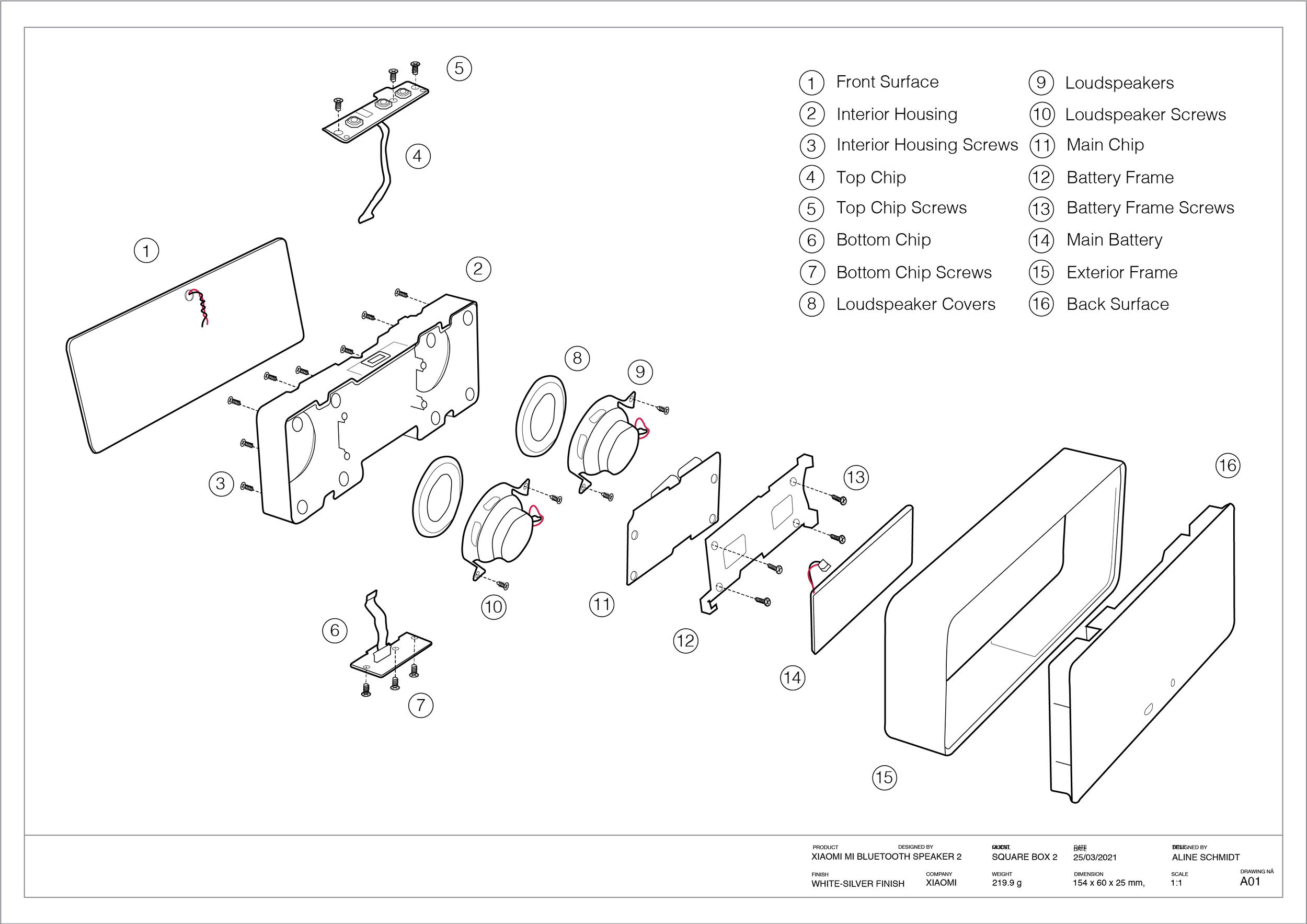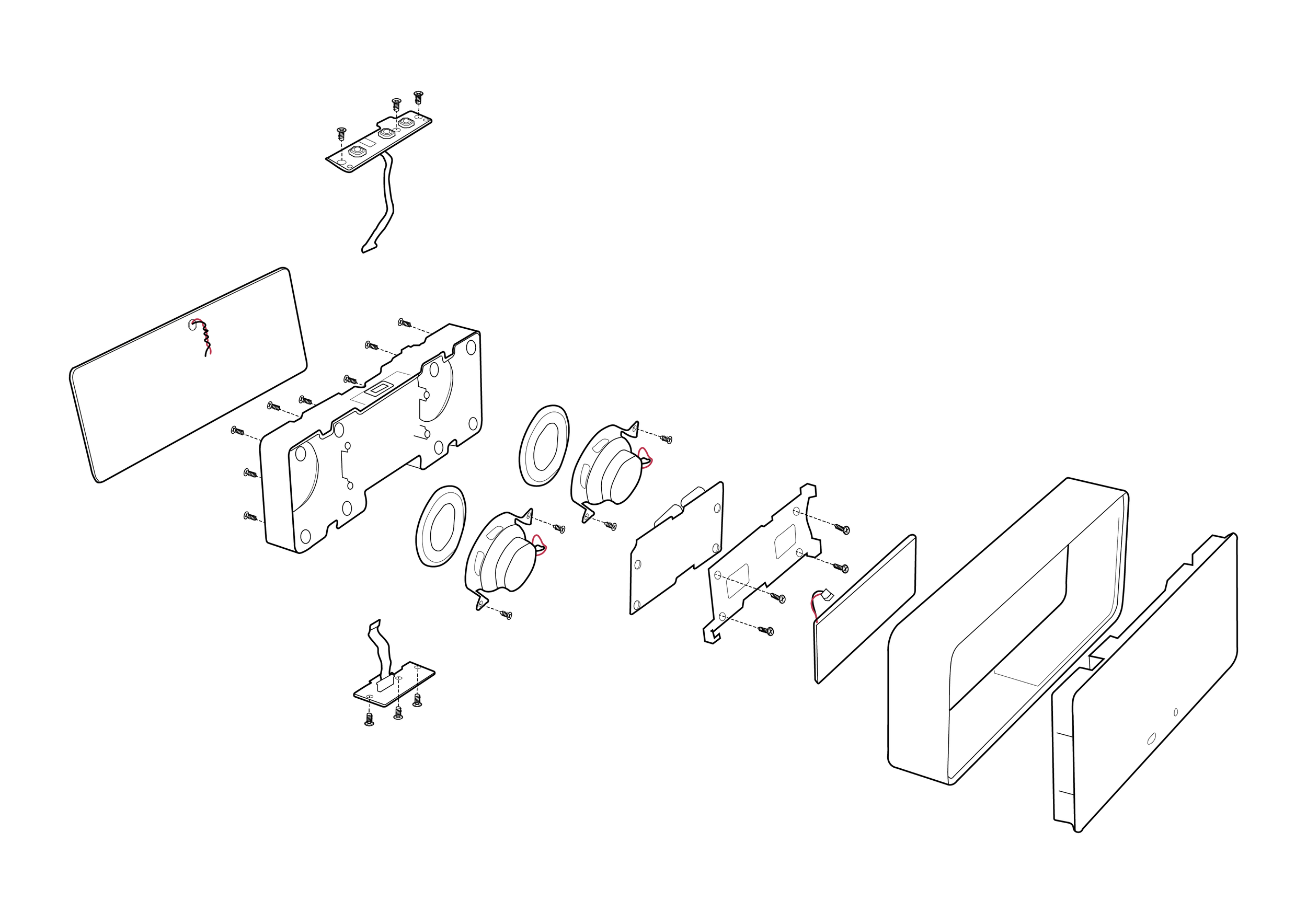
Product Design
Evolution Of A Loudspeaker
2021
Disassembling a Loudspeaker in order to become acquainted with the realm of materials and their manufacturing processes. Where do the materials come from and how are they made? What is the history of an everyday object ?
By dissecting the various components of what appears to be a simple and to some extent mundane device, the intricacy of its materials and interconnections were discovered. This ranged from grasping the financial considerations and manufacturing techniques involved in its production to realizing the near impossibility of effectively recycling these components.
Some of the project deliverables included:
Ikea-style manual
Usability Diagram
Blueprints
Apple Campaign
-
It all started 160 years ago. Interestingly, both the speaker and loudspeaker's early inventions lead to more specific distinctions designs. The evolution of both complement and are a part of each other as they share the central aspect of sound. The German teacher Johann Philip Reis, part of Edison Tech in 1861, was experimenting with sounds and invented what is known as the first hearing aid. Little did Reis know that his design would stimulate an honest exploration of the loudspeaker's sound and evolution. Johann Phillip Reis duplicated sounds from electrical transmissions.
Furthermore, in 1876, Alexander Graham Bell was second to design the speaker and created what is known today as the first telephone. He allowed for development in communication and sound. "Alexander Graham Bell patented his first electric loudspeaker capable of reproducing intelligible speech in 1876 as part of his telephone." (Bellis “Biography of Alexander”)
In 1877, Thomas Edison experimented with sounds and applied early concepts of Graham and Reis, but they did not work for what he aimed to do. Edison designed the "Tinfoil Phonograph." According to the Museum of Applied Arts and Sciences, "the many applications of the machine were envisioned too soon - the tinfoil structure was prone to tearing and produced low-quality sounds; often
indiscernible recordings accompanied with metallic background noise." (Balilo)
Later in the same year, on a cold December, in 1877, the German industrialist and inventor Ernst Werner von Siemens created the first loudspeaker. Von Siemens improved Bell's telephone by bringing the inside of the phone to the outside for a different yet similar function. In which the electrical audio signal is in corresponds to a complementary sound. Von Siemens applied the concept of "an electromagnetic coil to transport signals of the DC transients and also adding telegraphic signals." Werner von Siemens' loudspeaker's function was not practical as Siemens did not know yet how to amplify sounds; it ignited further exploration and improvements. Nikola Tesla was also created in 1881 though it was not patented (Cochran). To 'amplify' means "you make it louder, usually by using electronic equipment." ( “Amplify Definition and Meaning” Collins)
Furthermore, Thomas Alva Edison returned in the 1880s and refined the loudspeaker as he was the first, proper prior attempts, to amplify sounds. Horns were the earliest form of amplification that did not require electricity. Edison, however, was not the only one. Magnavox and Victrola, through similar periods, developed them from 1880 to the 1920s, where they reached significant popularity. Horns' functions included the recording of audio for entertainment purposes, record keeping, and voice radio. The problem with horns is that they could not amplify the sound very much. With the use of electrical amplification in the future loud sound could be generated to fill large public spaces. Horns remain a novelty for collectors today." (Edison Center Tech)
Moreover, it becomes evident that technological advances depend on advances in physics that impact engineering and design realms. The most successful and checking the categories of a mythical design is the first practical moving-coil (dynamic) loudspeaker designed by Peter L.Jensen and Edwin Pridham in California, USA, in 1915 (Bellis “Where Does the Loudspeaker Come From?” ). Similar to speaker prior loudspeakers, theirs used horns to amplify the sound produced by a small diaphragm. The issue was that Peter Jensen got denied a patent. Therefore, new doors opened for the two and changed their strategy, making it public address and radios systems.
However, the moving-coil technology commonly applied nowadays in speakers was patented in 1925 by Chester W. Rice and Edward W. Kellogg. Hence, people first believed it was invented by Kellogg and Chester Rice. The dynamic speaker's application or operation worked on the same principle as a dynamic microphone, except in reverse to produce sound from an electrical signal. Airplanes at the time had no way to tell height in cloudy conditions. He worked studying acoustics on Honnedaga Lake at his camp in the Adirondacks. The lake at night was completely silent, allowing him to do his work. His work with Edward Kellogg resulted in the world's first powerful dynamic loudspeaker. It was the first moving-coil loudspeaker in the world that helped refine the horn sound system's latest state. The two, on paper, created the first modern speaker and the second electronic amplifying system. The first attempts in 1921 were not as pleasing as they made muffle sounds, but they could get fresh, invigorating audio out of the
speakers. Their loudspeaker was installed at theaters across the United States as the demand for high amplifying sound systems for theaters was high and never been able before. Shockingly, 90% of their technology is still used today.
Yet, the history of the loudspeaker is long, not over.
In 1945, loudspeakers gained popularity due to further development by Altec Lansing and his "604 loudspeaker designed in 1943 and his "Voice of the Theatre" loudspeaker system was sold beginning in 1945." (Bellis “Where Does the Loudspeaker Come From?” ) Lansing's version provided an even better harmony and clarity at high output levels needed for loud spaces such as movie and concert theaters. His invention led to people buying his product design as they no longer had to visit these public spaces and enjoy their leisure time at home. It led to it being public and a product for the community.
In 1953 loudspeakers' sound quality developed intensely and powerful, strengthening theatre and the public. One year later, "Edgar Villchur created the acoustic suspension principle of loudspeaker design in Cambridge, Massachusetts. This design delivered better bass response and was important during the transition to stereo recording and reproduction" (Bellis “Where Does the Loudspeaker Come From?” ).
The following year, 1955, "The Academy of Motion Picture Arts and Sciences immediately began testing its sonic characteristics and they made it the film house industry standard" (Bellis “Where Does the Loudspeaker Come From?” ). Interestingly, "return of the Jedi" was the first movie to use the THX sound system (Cochran). Speakers have a timeless significance and quintessential to music lovers and sound enthusiasts. Thanks to Larry Schotz back in 1994, "patent for a digital wireless speaker system. The technology behind wireless speakers is quite
simple. A transmitter sends a radio frequency to a receiver sitting in a musical loudspeaker. Two, a board amplifier powers up the woofer." (Paler)
In conclusion, it's a matter of perspective who invented what first and who should be renowned for their invention. Who came first, the chicken or the egg? But, truth be told, developments go hand in hand, so do technology and music.
Works Cited
“Amplify Definition and Meaning: Collins English Dictionary.” Amplify Definition and Meaning | Collins English Dictionary, HarperCollins Publishers Ltd, www.collinsdictionary.com/dictionary/english/amplify. Accessed 23 Mar. 2021.
Balilo, Erica. “Edison Tinfoil Phonograph.” Edited by Sarah Reeves, MAAS, 2018, collection.maas.museum/object/236328. Accessed 23 Mar. 2021.
Bellis, Mary. “Biography of Alexander Graham Bell, Inventor of the Telephone.” ThoughtCo, 27 Apr. 2020, www.thoughtco.com/biography-alexander-graham-bell-4066244. Accessed 23 Mar. 2021.
Bellis, Mary. “Where Does the Loudspeaker Come From?” ThoughtCo, 28 Feb. 2018, www.thoughtco.com/history-of-loudspeaker-4076782.
Cochran, Zackery. “Evolution of Loudspeakers Timeline.” Timetoast, www.timetoast.com/timelines/evolution-of-loudspeakers. Accessed 23 Mar. 2021.
Edison Center Tech. “History and Types of Loudspeakers.” History and Types of Speakers, edisontechcenter.org/speakers.html. Accessed 23 Mar. 2021.
Paler, Bobby. “The Birth of Wireless Speakers.” Wireless Headphones - WirelessSpeakers.com, 23 Mar. 2021, wirelessspeakers.com/history/. Accessed 23 Mar. 2021.
-
This was a individual project directed by professor and designer Andrea Caruso.

01_Ikea-style manual

01_Ikea-style manual

01_Ikea-style manual

01_Ikea-style manual

01_Ikea-style manual

01_Ikea-style manual

01_Ikea-style manual

01_Ikea-style manual

01_Ikea-style manual

01_Ikea-style manual

01_Ikea-style manual

01_Ikea-style manual

02_Usability Diagram

03_Blueprints

03_Blueprints

Exploded Diagram

04_Apple Campaign_Digital Moodboard

04_Apple Campaign

04_Apple Campaign